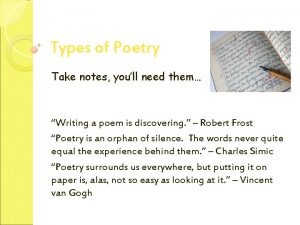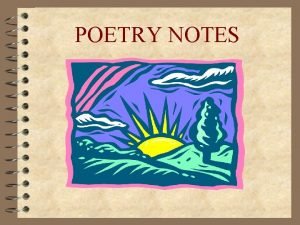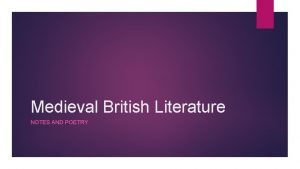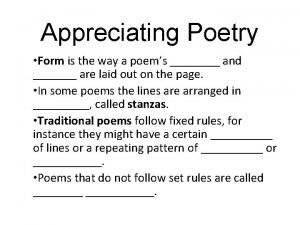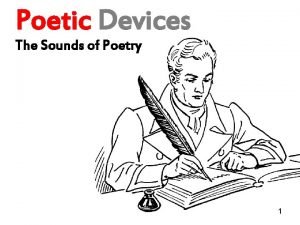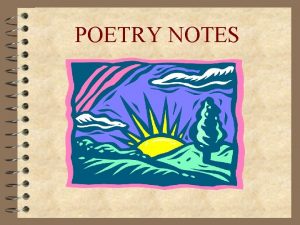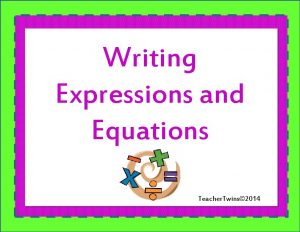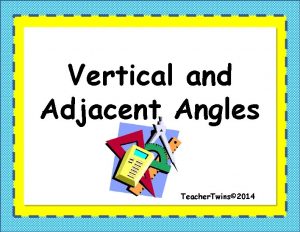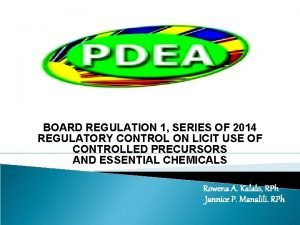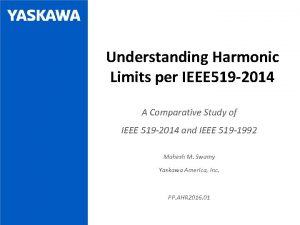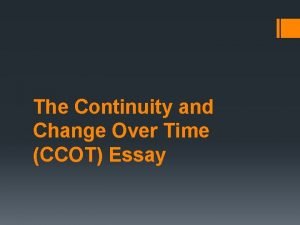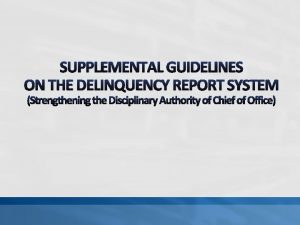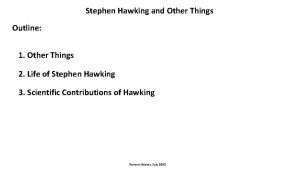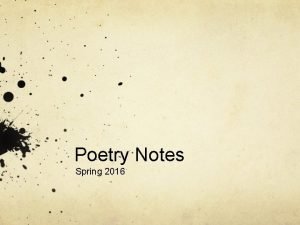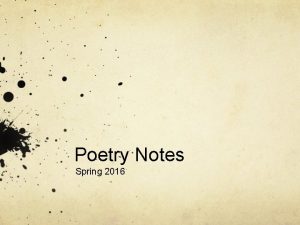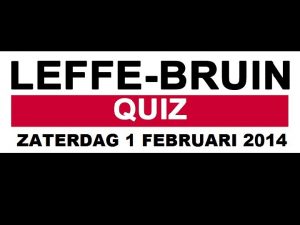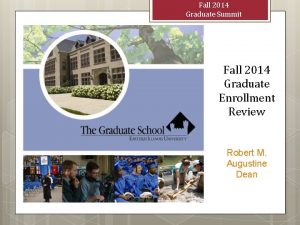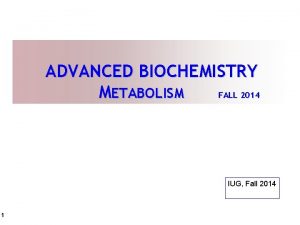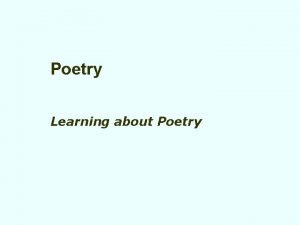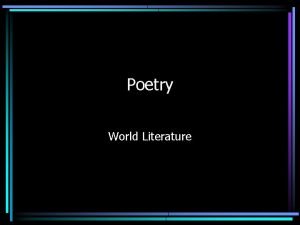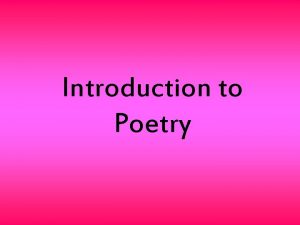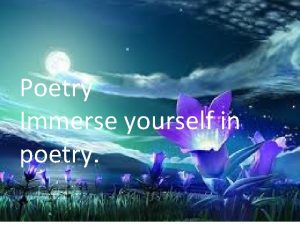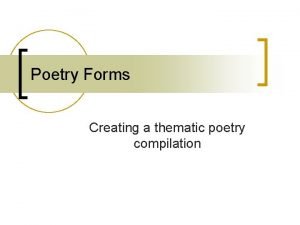Poetry Notes Fall 2014 What is poetry Poetry











![Synecdoche [si-nek-duh-kee] A figure of speech in which a part is substituted for the Synecdoche [si-nek-duh-kee] A figure of speech in which a part is substituted for the](https://slidetodoc.com/presentation_image_h2/194f270dd6269d2a3874e0552f8018c9/image-12.jpg)







- Slides: 19

Poetry Notes Fall 2014

What is poetry? Poetry contains both literary and musical features. On the literary side, poetry can use any combination of metaphor, simile, imagery, symbolism, allegory, even narrative or storyline. Denotation (direct meaning) and connotation (indirect meaning) help to further sculpt the literary meaning or sense of a poem. On the musical side, poetry uses rhyme, meter, assonance (similar vowels) and alliteration (similar consonants) to strike an aural mood or tone. Poetry can be ironic or humorous, attractive or ugly, mystical or mundane.

Alliteration The repetition of consonant sounds, especially at the beginning of words. Example: "Fetched fresh, as I suppose, off some sweet wood. " Hopkins, "In the Valley of the Elwy. "

Assonance The repetition of similar vowel sounds in a sentence or a line of poetry or prose, as in "I rose and told him of my woe. " Whitman's "When I Heard the Learn'd Astronomer" contains assonantal "I's" in the following lines: "How soon unaccountable I became tired and sick, / Till rising and gliding out I wander'd off by myself. "

Consonance is the repetition, at close intervals, of the final consonants of accented syllables or important words , especially at the ends of words, as in blank and think or strong and string or Lady lounges lazily and Dark deep dread.

End Rhyme When a poem has lines ending with words that sound the same. (noun). An example of end rhyme is the poem, Star Light, Star Bright.

Internal Rhyme in the same line comes when the words rhyme in a single line. For example, “Once upon a midnight dreary, while I pondered, weak and weary, “While I nodded, nearly napping, suddenly there came a tapping, As of someone gently rapping, rapping at my chamber door. ”

Personification The endowment of inanimate objects or abstract concepts with animate or living qualities. An example: "The yellow leaves flaunted their color gaily in the breeze. " Wordsworth's "I wandered lonely as a cloud" includes personification.

Imagery The pattern of related comparative aspects of language, particularly of images, in a literary work. Imagery of light and darkness pervade James Joyce's stories "Araby, " "The Boarding House, " and "The Dead. " So, too, does religious imagery.

Metaphor A comparison between essentially unlike things without an explicitly comparative word such as like or as. An example is "My love is a red, red rose, " From Burns's "A Red, Red Rose. " Langston Hughes's "Dream Deferred" is built entirely of metaphors. Metaphor is one of the most important of literary uses of language. Shakespeare employs a wide range of metaphor in his sonnets and his plays, often in such density and profusion that readers are kept busy analyzing and interpreting and unraveling them.

Simile A figure of speech involving a comparison between unlike things using like, as, or as though. An example: "My love is like a red, red rose. "
![Synecdoche sinekduhkee A figure of speech in which a part is substituted for the Synecdoche [si-nek-duh-kee] A figure of speech in which a part is substituted for the](https://slidetodoc.com/presentation_image_h2/194f270dd6269d2a3874e0552f8018c9/image-12.jpg)
Synecdoche [si-nek-duh-kee] A figure of speech in which a part is substituted for the whole. An example: "Lend me a hand. ” Another example: The word "wheels" refers to a vehicle.

Hyperbole A figure of speech involving exaggeration. John Donne uses hyperbole in his poem: "Song: Go and Catch a Falling Star. "

Symbolism The practice of representing things by symbols, or of investing things with a symbolic meaning or character. A symbol is an object, action, or idea that represents something other than itself, often of a more abstract nature. Symbolism creates quality aspects that make literature like poetry and novels more meaningful.

Lyric A type of poem characterized by brevity, compression, and the expression of feeling. The anonymous "Western Wind" epitomizes the genre: Western wind, when will thou blow, The small rain down can rain? Christ, if my love were in my arms And I in my bed again!

Narrative A poem that tells a story. Ballad- A narrative poem written in four-line stanzas, characterized by swift action and narrated in a direct style. The Anonymous medieval ballad, "Barbara Allan, " exemplifies the genre.

Fixed Form Generally, a form of poetry that has a name; specifically, any of the standard, highly-structured arrangements of meter, rhyme patterns, and/or topics that define a poem, such as a sonnet, sestina, etc.

Sonnet A fourteen-line poem in iambic pentameter. The Shakespearean or English sonnet is arranged as three quatrains and a final couplet, rhyming abab cdcd efef gg. The Petrarchan or Italian sonnet divides into two parts: an eight-line octave and a six-line sestet, rhyming abba cde or abba cd cd cd.

Couplet A pair of rhymed lines that may or may not constitute a separate stanza in a poem. Shakespeare's sonnets end in rhymed couplets, as in "For thy sweet love remembered such wealth brings / That then I scorn to change my state with kings. "
 Facteur g
Facteur g Notes on poetry
Notes on poetry Acrostic poems for kids
Acrostic poems for kids Medieval poetry in english literature
Medieval poetry in english literature Metaphysical poetry of john donne
Metaphysical poetry of john donne Appreciating poetry notes
Appreciating poetry notes Rat onomatopoeia
Rat onomatopoeia Refrain poem example
Refrain poem example Teacher twins 2014
Teacher twins 2014 Who traditional medicine strategy 2014-2023
Who traditional medicine strategy 2014-2023 Teacher twins@2014
Teacher twins@2014 Ddb board regulation #1 s. 2014
Ddb board regulation #1 s. 2014 Ieee 519 harmonic limits
Ieee 519 harmonic limits Continuity and change thesis
Continuity and change thesis Delinquency report pnp
Delinquency report pnp Hawking
Hawking 2014 special olympics
2014 special olympics Social services and wellbeing act easy read
Social services and wellbeing act easy read Social services and wellbeing (wales) act 2014 easy read
Social services and wellbeing (wales) act 2014 easy read Agosto 2014
Agosto 2014

